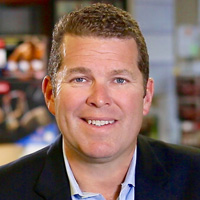“Mrs. Mills, his lungs are smaller than average for his age AND he has asthma. He’ll need to lead a less active life. I suggest he learn to play chess.” I can remember that doctor’s words as if it were yesterday. I was lucky—my parents keep pushing me to decide what I could do, and not to let the diagnosis hold me back from doing things I wanted to do.
At first, things did not go well for me. I tried basketball, and the only basket I ever scored was for the opposing team. Then I tried soccer, but my speed was lacking, and as a defender during my second game, I kicked the ball back to my goalie only to accidentally score…against us. I tried two more sports, lacrosse goalie and hockey fourth-line defender, and had similar scoring outcomes. I scored against my own teams in four sports. My self-esteem in 8th grade was at an all-time low. I really wanted to do something athletic, but the kids I competed with and against just seemed to be on a different physical level than me.
In 9th grade, I went to a boarding school in Northwest Connecticut called Kent School. It was there I found the sport of rowing and learned to set my first goal. Kent was known for crew, particularly 8-man rowing shells. The varsity program had two boats—first boat and second boat—and they would travel the US and England to compete at the most advanced high school levels. I had not even picked up an oar as a freshman when I decided my goal was to make one of those two boats as a sophomore. Up until that moment, I had never committed myself to accomplish something that I wanted. Sure, I worked hard at getting good grades or trying to be a good teammate in the various sports I tried, but none of those things kept me focused on accomplishing something very specific…until I set my sights on rowing.
I told my parents during the parent’s weekend of my freshman year that I wanted to make the Kent School Boat Club (KSBC) second boat. Of course, they had no idea what I was referring to, but my Mom said, “Alden get out a piece of paper, write that goal down, and tape it to your wall where you’ll see it every day.” I told her I did not need to do that because I already knew what I wanted. She smiled and said, “Trust me, just write it down and put it where you’ll see it.” I thought it was a little odd, but I was so desperate to make this goal my reality that I decided to do it.
I was embarrassed at first. My roommate saw my note and laughed at me as he said, “You are crazy! You practically got thrown out of your club boat!” (He was right about that, I caught a “crab,” meaning I didn’t get my oar out of the water in time and nearly got flung out of the boat.) Friends would see my note and their feedback was not much different from my roommate's. I did not care. I wanted this goal for several reasons. For starters, I knew I could be good at it. I spent my summers on Cape Cod rowing a little wooden dory every single day. I loved that boat and the freedom it offered me. Second, I desperately wanted to be good at something athletic. I had failed a lot in the past, and I wanted to find a sport where I could succeed and show everyone that I was not just good, but great. And third, I loved the idea of 8 people working in perfect harmony to go fast and win races. There were no MVPs or lead scorers—just 8 teammates working together to win.
There is a lot more to this story, and I will share it with you in the next blog posts, but the first point I want you to understand is the importance of making a goal. From that point in high school going forward, I have made A LOT of goals in my life. Over the past 36 years since making that first goal, I have learned so much about goal setting. Now, I want to share it with you because knowing how to set goals will dramatically enrich your life. That’s right—if you learn to set goals, you will change the direction of your life. I am a firm believer that our lives are up to us. Goals give us direction; help us optimize our time, talent, and energy; achieve things that we desire; and consequently, improve our lives. Who doesn’t want that?!
First, I want you to understand that there are three main components of any goal. They are: “the What,” “the Why,” and “the How.” In this blog post, we are going to discuss the “What” and the “Why.” The first part is knowing “What is my goal.” I want you to answer this question: “What do I want?” In the case of my very first goal, I was quite specific: “I want to make the second boat of KSBC in my sophomore year.” This statement is important because it contains two important elements you must have in making a goal: What and When. My “what” was “KSBC second boat” and my “when” was sophomore year. Goals are dreams with deadlines. When you make a goal you need to be specific about what it is you want and when you want it. While working on your “when,” you need to gauge the timing of your goal realistically. I could have said, “I want to make KSBC by the end of freshman year,” but I would have failed miserably because I did not know how to row yet. Even though many thought my sophomore year was still unrealistic, I figured if I committed myself, then it was worth finding out how far I could go.
The second component of making a goal is understanding “Why” you want it. Now, this may seem like a simple exercise to you (who doesn’t want to win the lottery?!), but going after something you have not done or achieved is hard work. It is not only hard, but also lonely (we’ll discuss how we overcome this in the next blog post). Your “why” behind your “what” will power you to keep going when you are battling those demons of doubt that I assure you will come knocking as you pursue your goal. The best way to connect to your “why” is through your emotions. One of the most powerful tools we have is the ability to envision a future that does not yet exist. When we envision something, we do not just see it—we experience it. When we experience something, we are activating all of our senses: touch, sight, sound, feelings, smell, and taste. The more senses you activate while envisioning you achieving your goal, the more you are anchoring your brain to seek the experience in reality. This takes practice, but the good news is that practice can be fun.
Envisioning is about dreaming up what it is like to achieve your goal. In my case, I daydreamed daily about walking around campus wearing my KSBC windbreaker, wearing my racing shirt as I rowed down the river, raising my arms in triumph after winning the New England championship, coming home to hanging a medal on my wall, telling my friends and family I made the KSBC second boat…the list goes on. In each one of these moments, I envisioned what it would be like to live in that moment. Having a good "why" is great, but envisioning your "why" is critical. I want you to teach your brain (and your body—yes, your body will follow your brain) what it feels like to accomplish your goal. The more your brain is trained to experience the goal you seek, the more it will help you achieve that goal.
One more thing about making a goal: if you have not made a goal or have not made one in a long time, then start small. Let's get some goal points on the board! Pick a goal that gets you Fired UP. Envision that goal and set a realistic time frame for yourself. Write down your goal, and make it specific, because we want to be able to measure it. The more we can measure it, the more we track it; and the more we can track it, the more motivated we become from the progress we make.
This first step of making a goal is the first action you take in GoalBud. We made GoalBud to help you achieve more. GoalBud will be ready for download on March 1, 2023—the wait is almost over! While you wait for GoalBud to launch, I want you to be ready to use it immediately, so here’s your homework in preparation for the next blog post and the launch of GoalBud:
“Who are the people that can help you achieve your goal?”
Make a list and get ready to learn how to build your secret weapon to goal success—building a Goal Team.
Be Unstoppable!
Alden





